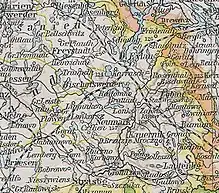The Löbau district (German: Kreis Löbau) was a Prussian district in the Marienwerder administrative region that existed from 1818 to 1920. The seat of the district administration was in the city of Neumark. The district belonged to the part of West Prussia that fell to Poland after World War I through the Treaty of Versailles in 1920. Today, the territory of the district is in the Warmian-Masurian Voivodeship in Poland.


History
The area of the Löbau district was annexed by Prussia during the First Partition of Poland in 1772 and belonged to the Michelau district until 1818.[1] In 1815, the area became part of Regierungsbezirk Marienwerder in the province of West Prussia. As part of a comprehensive district reform, the Michelau district was divided into the Löbau and Strasburg districts on April 1, 1818. From December 3, 1829 to April 1, 1878, West Prussia and East Prussia were united as the Province of Prussia, which had belonged to the German Empire since 1871. After World War I, the largely Polish-speaking district of Löbau had to be ceded to Poland on January 10, 1920 in accordance with the Treaty of Versailles.
Demographics
| 1831 | 1861 | |||
|---|---|---|---|---|
| Germans | 3,868 | 14.3% | 8,956 | 20.8% |
| Poles | 23,225 | 85.7% | 34,059 | 79.2% |
| Total | 27,093 | 43,015 | ||
Elections
In the German Empire, the district of Löbau together with the district of Rosenberg formed the Reichstag constituency of Marienwerder 2. The constituency was always won by conservative candidates except for the elections of 1890 and 1893, in which the Polish candidate won.[3]
Municipalities
In 1910, the Löbau district comprised the two towns of Löbau and Neumark as well as 97 rural communities:[4]
|
|
References
- ↑ Goldbeck, Johann Friedrich (1789). Volständige Topographie des Königreichs Preussen (in German). Auf eigene Kosten und in eignem Verlage.
- ↑ Belzyt, Leszek (1998). Sprachliche Minderheiten im preussischen Staat: 1815 - 1914 ; die preußische Sprachenstatistik in Bearbeitung und Kommentar. Marburg: Herder-Inst. ISBN 978-3-87969-267-5.
- ↑ "Parlamentarierportal biorab Kaiserreich". 2015-01-06. Archived from the original on 2015-01-06. Retrieved 2021-02-03.
- ↑ "Willkommen bei Gemeindeverzeichnis.de". www.gemeindeverzeichnis.de. Retrieved 2021-02-03.